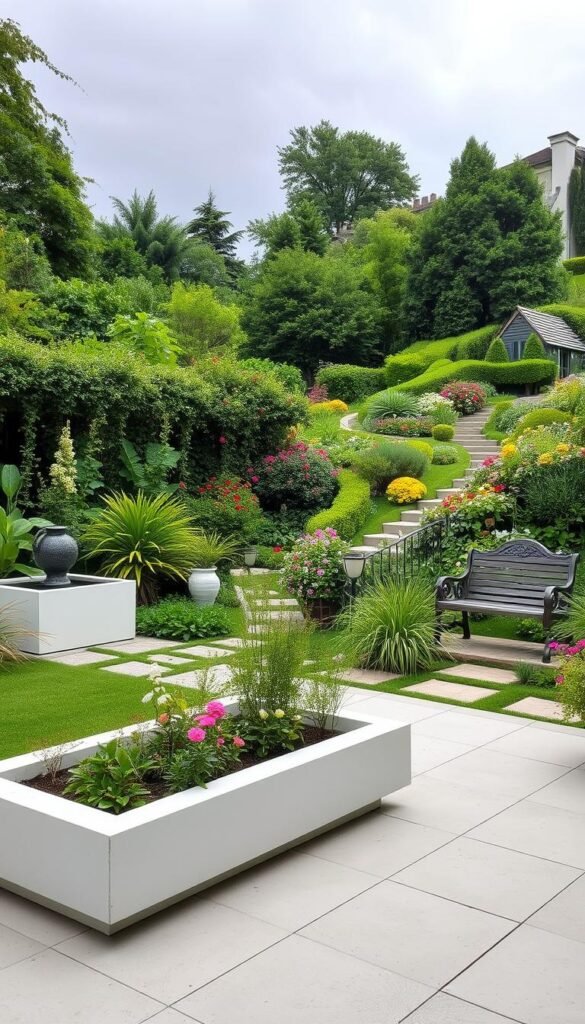Outdoor spaces have become an extension of personal style, with two distinct trends gaining popularity. On one hand, you have clean, structured layouts with a focus on simplicity. On the other, wilder arrangements embrace a cozy, nostalgic feel.
These approaches represent completely different visions for your space. One prioritizes open areas and sleek lines, while the other celebrates abundance and whimsical charm. Your choice depends on how you want to use your outdoor area and the mood you wish to create.
This guide will help you understand the core differences between these styles. You’ll learn about plant selections, color palettes, and upkeep requirements. Whether you prefer one look or want to mix elements, we’ll help you design a garden that fits your lifestyle.
Understanding Minimalist and Cottagecore Garden Styles
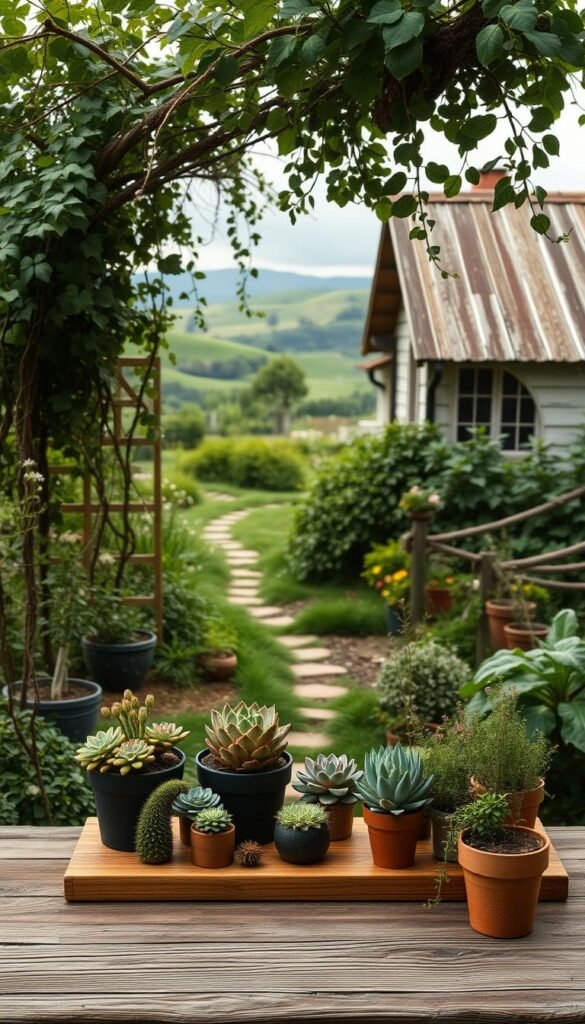
Two contrasting visions for your outdoor space offer unique ways to connect with nature. One embraces clean lines and open areas, while the other revels in layered textures and vintage charm. Your choice shapes not just the look but the feel of your surroundings.
What Defines a Minimalist Garden?
Minimalist design focuses on simplicity. Think geometric shapes, neutral colors, and plenty of negative space. Evergreens and architectural plants like succulents often star here.
This style prioritizes low upkeep. Every element has a purpose, creating a serene retreat. It’s perfect if you crave order and modern flair.
What Defines a Cottagecore Garden?
Cottagecore gardens celebrate wild beauty. Inspired by English countryside traditions, they mix heirloom roses, climbing vines, and curved pathways. Vintage accents like weathered benches add nostalgia.
These gardens buzz with life, attracting pollinators with diverse flowers. They’re ideal if you love a cozy, lived-in aesthetic.
Key Differences Between Minimalist and Cottagecore Gardens
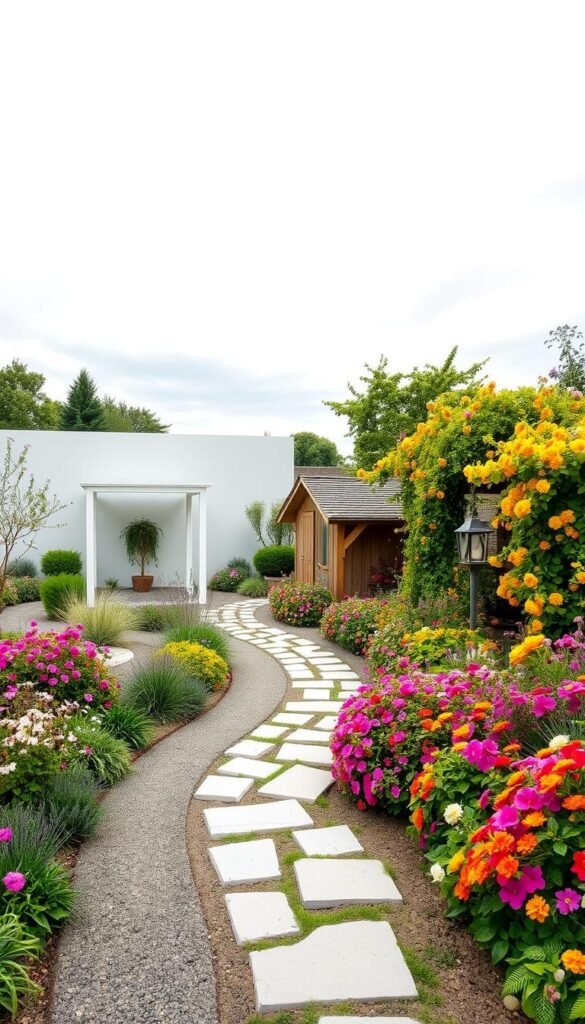
Your outdoor area can reflect two distinct personalities—one crisp and refined, the other lush and nostalgic. These approaches differ in everything from plant choices to upkeep routines. Understanding these contrasts helps you craft a space that aligns with your lifestyle.
Design Philosophy: Simplicity vs. Abundance
Minimalist gardens thrive on restraint. Think geometric shapes, monochromatic colors, and open areas. Every element serves a purpose, creating a serene retreat.
Cottagecore gardens embrace controlled chaos. Overflowing flower beds, curved pathways, and vintage accents evoke warmth. This style celebrates layered textures and a sense of history.
Color Schemes and Textures
Colors set the tone. Minimalist palettes often use three shades or fewer—think greens, whites, and grays. Cottagecore mixes pastels with bright pops for a playful vibe.
- Texture: Uniform leaves (minimalist) vs. mixed foliage (cottagecore).
- Lines: Straight edges create order; curves invite exploration.
- Materials: Concrete (minimalist) vs. reclaimed wood (cottagecore).
Maintenance varies too. Minimalist design demands weekly pruning for clean lines. Cottagecore allows for a controlled wildness, blending structure with natural growth.
Design Elements for a Minimalist Garden
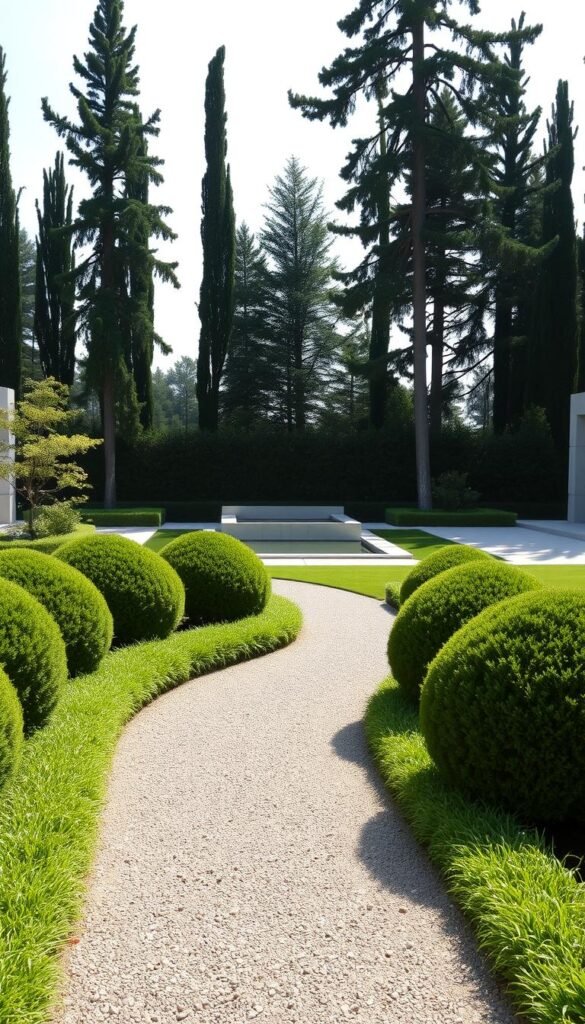
Less clutter and more purpose define the heart of minimalist garden design. Every element serves a function, creating harmony between structure and nature. This approach works especially well in small spaces, where simplicity makes areas feel larger.
Clean Lines and Structured Layouts
Japanese Zen gardens inspire this style’s focus on clean lines. Geometric shapes—think rectangular beds or circular stone paths—create visual flow. Avoid overcrowding; instead, let negative space highlight key features.
Hardscape materials anchor the design. Consider these options for a polished look:
| Material | Best Use | Maintenance Level |
|---|---|---|
| Polished stone | Pathways, borders | Low |
| Smooth concrete | Modern planters, seating | Medium |
| Corten steel | Focal points, edging | High (weathers naturally) |
Neutral Colors and Limited Plant Varieties
A restrained palette enhances the aesthetic. Stick to greens, whites, and grays for cohesion. Ornamental grasses or boxwood hedges add texture without chaos.
Lighting should be subtle. Discreet LED strips under benches highlight clean lines, unlike cottagecore’s fairy lights. Remember: one striking focal point—like a single maple tree—outshines crowded flower clusters.
- Plant smart: Dwarf conifers and succulents need little pruning.
- Edit ruthlessly: Remove anything that doesn’t serve the design.
- Balance: Pair natural materials with sleek finishes.
Design Elements for a Cottagecore Garden
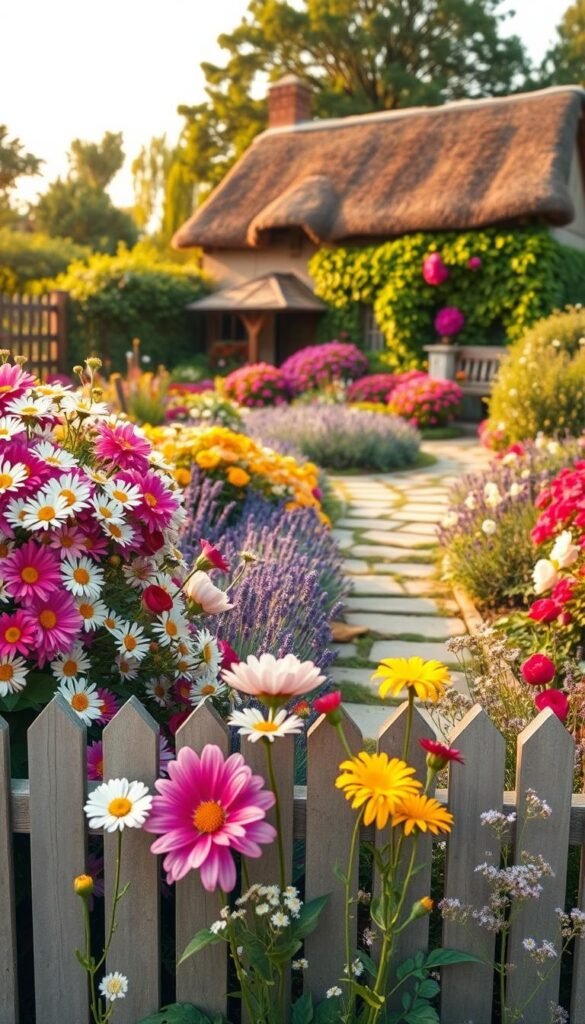
A cottagecore garden wraps your space in nostalgic charm and wild beauty. Think overflowing flower beds, winding paths, and timeworn accents that feel plucked from a countryside storybook. This style thrives on a mix of nature and handcrafted details.
Layered Plantings and Wild Beauty
Use the lasagna planting technique for dense, textured beds. Start with tall blooms like delphiniums, layer mid-height lavender, and edge with creeping thyme. Climbing roses, such as Rosa ‘Madame Ernest Calvat,’ add vertical drama on arbors.
Pollinators love these plant pairings. Combine foxgloves with catmint or daisies with salvia for a lively, eco-friendly garden. Let plants spill over edges for a relaxed, romantic feel.
Vintage and Rustic Accents
Vintage touches complete the look. Weathered benches, wrought-iron gates, and terracotta pots add character. Hunt for flea-market finds like chipped bird baths or enamel watering cans.
- DIY projects: Build a twig trellis for sweet peas or moss-covered planters for ferns.
- Materials: Reclaimed wood and aged metals blend seamlessly with flowers.
- Lighting: String fairy lights through vines for evening magic.
This aesthetic isn’t about perfection—it’s about creating a space that feels alive and loved. Every chip and curve tells a story.
Choosing Plants for a Minimalist Garden
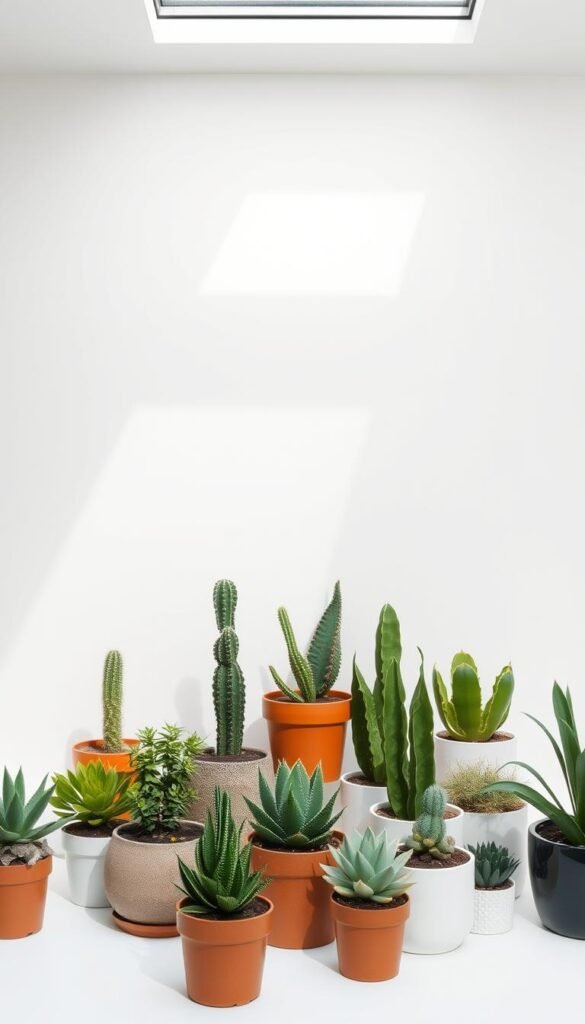
Selecting the right plants elevates a minimalist garden’s clean aesthetic. Focus on species that highlight form and require little upkeep. These choices ensure your garden stays uncluttered and intentional.
Low-Maintenance and Architectural Plants
Snake plants and yuccas add vertical interest without crowding. Their sharp clean lines complement geometric layouts. For contrast, blue fescue grass softens edges with wispy texture.
Drought-tolerant succulents thrive in arid climates. Agave or echeveria work well in small spaces, like patios. Pair them with gravel mulch to enhance simplicity.
Evergreens and Monochromatic Blooms
Boxwood pyramids or holly topiaries provide year-round structure. Their dense foliage holds sharp shapes with seasonal pruning.
Stick to a single colors palette for blooms. White tulips in spring can transition to hydrangeas in summer. This creates continuity without visual chaos.
- Container tips: Use sleek concrete pots for a unified look.
- Pruning: Trim every 3 weeks to maintain crisp edges.
- Growth habits: Choose upright junipers over spreading varieties.
Choosing Plants for a Cottagecore Garden
Transform your outdoor retreat with timeless blooms that whisper stories of old-world charm. A cottagecore garden thrives on heritage plants and romantic, free-spirited growth. From fragrant roses to cascading vines, each choice adds layers of texture and life to your space.
Heirloom Roses and Fragrant Flowers
Rosa ‘Great Maiden’s Blush’—a 15th-century variety—epitomizes vintage charm. Its soft pink petals and sweet scent pair perfectly with catmint or campanula. This companion planting technique boosts biodiversity while enhancing visual appeal.
For sensory delight, add these fragrant stars:
- Lilacs: Their purple clusters perfume spring air.
- Peonies: Voluminous blooms in blush or crimson.
- Night-blooming jasmine: Intoxicating evening fragrance.
Perennials and Climbing Vines
Clematis and honeysuckle weave vertical magic on arbors or fences. Their sprawling habit creates a living curtain of flowers. For edible flair, mix in nasturtiums or calendula—their bright petals spice up salads.
Maximize small spaces with vertical tricks:
- Bean teepees: Rustic supports for climbers.
- Rose arches: Frame pathways with blooming elegance.
Plan for year-round color with this seasonal bloom guide. Spring pansies give way to summer geraniums, while fall sedum adds fiery hues.
Gardening Aesthetic Ideas: Minimalist vs. Cottagecore Styles
Your outdoor retreat doesn’t need to follow just one design philosophy—mixing elements creates magic. Combine the serenity of clean lines with the warmth of overflowing blooms for a fusion that feels uniquely yours. Whether you have a tiny patio or sprawling lawn, blending these styles maximizes your space.
Strategies for Blending Both Styles
Start with a minimalist backbone. Use geometric pathways or sleek planters as anchors. Then, soften edges with cottagecore touches—think trailing petunias in modern steel boxes or wildflowers bordering structured hedges.
Try these hybrid ideas:
- Zoning: Keep the front yard formal (boxwood hedges) and let the backyard run wild (climbing roses).
- Materials: Pair concrete benches with vintage-style lanterns for contrast.
- Planting:
- Drought-resistant lavender (cottagecore) in symmetrical rows (minimalist).
- Succulents (minimalist) nestled among heirloom daisies (cottagecore).
Assessing Your Space and Lifestyle
Match your garden to your routine. Low-maintenance cottagecore plants (like coneflowers) suit busy schedules. High-maintenance minimalist hedges demand weekly trims.
Consider these factors:
- Sunlight: Full-sun areas favor lavender; shaded spots host ferns.
- Climate: Opt for native plants—yucca for arid zones, hydrangeas for temperate.
- Size: Small yards benefit from vertical design (wall-mounted planters with ivy).
Your outdoor space should reflect your life. Whether you lean toward structured calm or whimsical abundance—or a bit of both—the right blend creates a timeless aesthetic.
Creating Your Dream Garden: Final Tips and Inspiration
Your outdoor space should reflect your personality and daily life. Whether you prefer sleek simplicity or wild charm, small steps make a big impact. Start with herb spirals or container setups—they’re easy to manage and instantly elevate your aesthetic.
For fresh inspiration, visit local botanical gardens. Notice how they blend structure with nature. Sustainable touches like rainwater barrels or compost bins add eco-friendly flair. These choices honor the world while enhancing your retreat.
Connect with fellow plant lovers through community swaps. Sharing cuttings or tips builds knowledge and friendships. Remember, as designer Marwa Haydar advises, great design balances history with modern needs. Let your garden tell your unique story—one bloom at a time.

